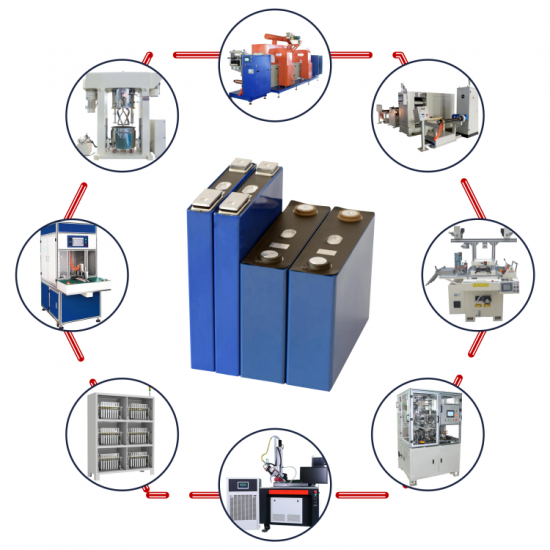Lith Corporation, founded in 1998 by a group of material science doctor from Tsinghua University, has now become the leading manufacturer of battery lab&production equipment. Lith Corporation have production factories in shenzhen and xiamen of China.This allows for the possibility of providing high quality and low-cost precision machines for lab&production equipment,including: roller press, film coater,mixer, high-temperature furnace, glove box,and complete set of equipment for research of rechargeable battery materials. Simple to operate, low cost and commitment to our customers is our priority.
What is an EV Car Battery Fabrication Line?
An EV (Electric Vehicle) Car Battery Fabrication Line refers to the entire manufacturing system used to produce lithiumion battery cells for electric vehicles. This includes all stages from raw material preparation to final cell testing and sorting, forming the core of any modern battery production facility.
Unlike labscale or pilot lines, which focus on research and process validation, a fabrication line is designed for highvolume, repeatable, and automated production of battery cells with consistent quality and performance.
Such a line is essential for:
Battery manufacturers (e.g., CATL, LG Energy Solution, Panasonic, BYD)
Automotive OEMs vertically integrating battery production (e.g., Tesla, BMW, Ford)
New entrants building gigafactories to meet growing EV demand
A full fabrication line ensures that each step — from electrode manufacturing to final formation and aging — is optimized for efficiency, yield, and safety, while meeting stringent automotivegrade quality standards.
Key Objectives of an EV Battery Fabrication Line
1. Mass Production of HighQuality Battery Cells
Ensure consistent electrochemical performance across millions of cells
Meet strict automotive requirements for energy density, cycle life, and safety
2. Scalability and Cost Efficiency
Enable gigawatthour (GWh) scale production
Optimize material usage, labor, and energy consumption
3. Automation and Digital Integration
Implement smart manufacturing systems (MES, SCADA, IoT sensors)
Improve traceability, reduce human error, and enable predictive maintenance
4. Process Control and Quality Assurance
Monitor key parameters (thickness, coating weight, weld strength, etc.)
Detect and correct deviations in realtime
5. Safety and Environmental Compliance
Handle flammable solvents and reactive materials safely
Comply with fire suppression, ventilation, and emissions regulations
Types of EV Battery Fabrication Lines
Depending on the cell format, fabrication lines can be classified into three main types:
1. Cylindrical Cell Fabrication Line
Commonly used by Tesla and others (e.g., 2170, 4680 cells)
Involves winding electrodes into a jellyroll and inserting into a metal can
Known for high thermal stability and ease of packlevel redundancy
2. Pouch Cell Fabrication Line
Uses stacked electrodes enclosed in aluminum laminate pouches
Offers flexibility in shape and size
Widely adopted in passenger EVs and energy storage systems
3. Prismatic Cell Fabrication Line
Features stacked or wound electrodes in rigid rectangular cases
Provides good mechanical stability and packaging efficiency
Used by many OEMs including BMW, Hyundai, and Renault
Each type has its own dedicated equipment and process flow, but they share many common steps.
Core Stages in an EV Battery Fabrication Line
Below are the key stages involved in a typical lithiumion battery cell fabrication line:
1. Electrode Manufacturing
This is the foundation of the entire fabrication line, where both anode and cathode electrodes are produced.
a. Slurry Preparation
Mixing active materials (e.g., NMC, LFP), conductive agents, and binders with solvents
Ensuring uniform dispersion and desired viscosity
Typically done in highshear mixers under controlled conditions
b. Electrode Coating
Applying slurry onto current collectors:
Copper foil for anodes (graphitebased)
Aluminum foil for cathodes (e.g., NMC, LFP)
Slotdie coating is preferred for precision and consistency
Thickness control is critical for performance and safety
c. Drying
Removing solvents in multistage drying ovens
Maintaining low dew point and solvent recovery systems
Ensures no residual moisture remains in the electrode
d. Calendering
Pressing the dried electrode to achieve uniform thickness and density
Affects ion transport and overall energy density
Monitored using laser gauges for tight tolerances
e. Slitting
Cutting coated electrodes into strips of precise width
Minimizing burrs and edge damage to avoid internal shorts
Laser or rotary slitters may be used depending on volume and quality needs
2. Electrode Assembly
Once the electrodes are ready, they are assembled into either a stacked or wound configuration.
a. Stacking (for Pouch and Prismatic Cells)
Alternating positive and negative electrodes with separators
Precision stacking machines ensure alignment and spacing
Often uses vision systems for accuracy
b. Winding (for Cylindrical and Some Prismatic Cells)
Creating a "jellyroll" by winding cathode, separator, and anode together
Tension control and speed synchronization are critical
Automated winding machines ensure repeatability
3. Cell Assembly
After electrode assembly, the components are inserted into the casing and sealed.
a. Casing Insertion
Placing the electrode stack/jellyroll into the cell casing
Testing different casing materials (e.g., steel, aluminum)
b. Tab Welding
Connecting electrode tabs to the terminals using laser welding
Ensuring strong electrical contact and structural integrity
Inspections verify weld depth and strength
c. Electrolyte Filling
Injecting liquid electrolyte in a dry room environment (<1% RH)
Different formulations can be tested for performance and safety
Requires solventfree handling and closedloop filling systems
d. Sealing
Closing the cell hermetically using crimping, laser welding, or ultrasonic sealing
Leak testing ensures longterm reliability and prevents swelling or failure
Battery Line Machine
4. Formation and Aging
These steps activate the cell and stabilize its internal chemistry.
a. Formation
First charge/discharge cycle to form the SEI layer on the anode
Done under tightly controlled current and voltage profiles
Realtime monitoring helps identify defective cells early
b. Aging
Allowing the cell to rest under controlled conditions for several days
Helps detect gas generation, internal shorts, or other defects
Thermal chambers simulate accelerated aging for faster results
5. Final Testing and Sorting
Before shipment, each cell undergoes rigorous testing.
a. Electrical Testing
Measuring capacity, internal resistance, and selfdischarge rate
Conducting charge/discharge cycles at various rates and temperatures
b. Safety Testing
Overcharge, short circuit, crush, and nail penetration tests
Thermal runaway detection and protection mechanisms
c. Mechanical Testing
Compression, vibration, and impact testing to ensure durability
d. Sorting and Grading
Grouping cells based on performance metrics
Ensuring balanced packs when integrated into modules and packs
Supporting Systems in an EV Battery Fabrication Line
To ensure safe, efficient, and highquality production, several supporting systems are essential:
1. Clean Room and Dry Room Infrastructure
Maintains ultralow humidity (<1% RH) for sensitive processes like coating and electrolyte filling
Includes air filtration, humidity control, and solvent recovery systems
2. Fire Suppression and Safety Systems
Gas suppression systems (e.g., FM200, Novec 1230) protect against thermal events
Explosionproof enclosures and emergency shutdown systems
3. Manufacturing Execution System (MES)
Tracks every batch, process parameter, and test result
Enables full traceability and supports root cause analysis
4. Data Acquisition and Analytics
Realtime monitoring of temperature, pressure, current, and voltage
Predictive analytics help optimize yield and reduce downtime
5. Waste Management and Sustainability Systems
Solvent recovery units minimize environmental impact
Recycling systems for scrap electrodes and rejected cells
Benefits of an EV Battery Fabrication Line
Enables largescale EV adoption through reliable, highvolume production
Reduces cost per kWh through automation and process optimization
Improves battery performance via tight process control and advanced materials
Enhances supply chain independence for automotive OEMs
Supports innovation by integrating new chemistries and formats (e.g., silicon anodes, dry electrode tech)
Meets global demand with scalable gigafactory models
Design Considerations for an EV Battery Fabrication Line
When planning or expanding your fabrication line, consider the following factors:
Cell Format – cylindrical, pouch, or prismatic?
Battery Chemistry – NMC, LFP, solidstate, etc.?
Annual Capacity Target – 1 GWh, 10 GWh, or 100 GWh?
Level of Automation – semiauto or fully automatic?
Factory Layout and Logistics – space, workflow, and clean room design
Integration with Module/Pack Line – seamless vertical integration
Environmental Compliance – emissions, waste treatment, and sustainability
Local Supply Chain and Labor Availability – impacts cost and scalability
Leading Companies Providing EV Battery Fabrication Line Equipment
Several global companies offer turnkey solutions or key components for battery fabrication lines:
CATL, BYD, LG Energy Solution, Panasonic – Inhouse developed lines and technologies
KUKA, B&R (ABB), Siemens – Automation and digitalization platforms
Hanson Robotics, Gree EnergyTech – Integrated battery production systems
BASF, Umicore, 3M – Material suppliers for cathodes, anodes, and binders
Trumpf, Coherent, IPG Photonics – Laser welding and cutting systems
MTI Corporation, Enerize, Toyo Seiki – Lab and smallscale production tools
Asahi Kasei, Toray Industries – Separator and membrane suppliers
Need Help Designing or Optimizing Your EV Battery Fabrication Line?
If you're looking to build, expand, or optimize your EV battery fabrication line, I can help you with:
Process Flow Design – from raw materials to finished cells
Factory Layout Planning – maximizing space and workflow efficiency
Equipment Selection – recommending bestinclass machinery
Automation Strategy – choosing the right level of automation
Cost Estimation – budget planning based on capacity and complexity
Custom Solutions – adapting the line to your specific chemistry or format
All you need to do is provide the following information:
Battery chemistry and format (NMC, LFP, cylindrical, pouch, prismatic)
Desired annual production capacity (in GWh)
Level of automation required (manual/semiauto/fullauto)
Target application (passenger cars, commercial vehicles, energy storage)
Current factory layout and infrastructure details



 Online service
Online service
